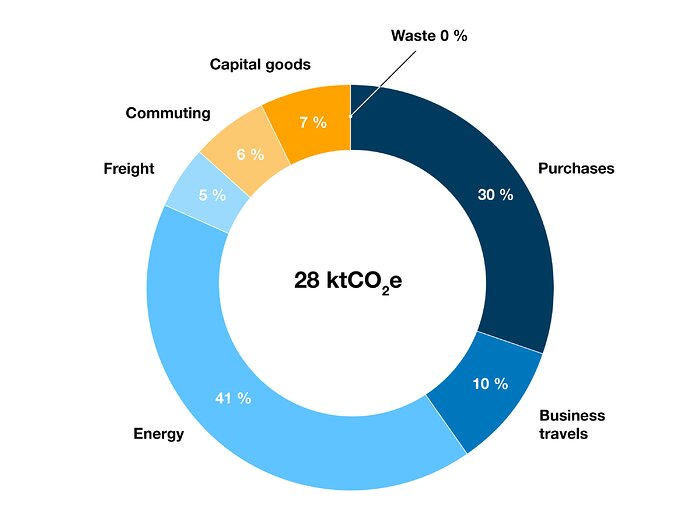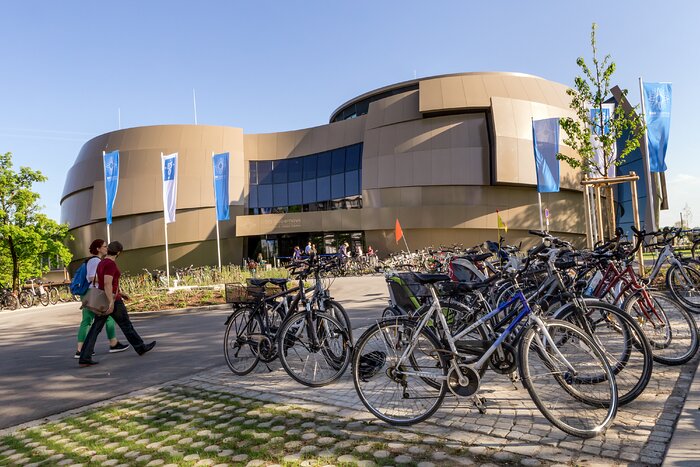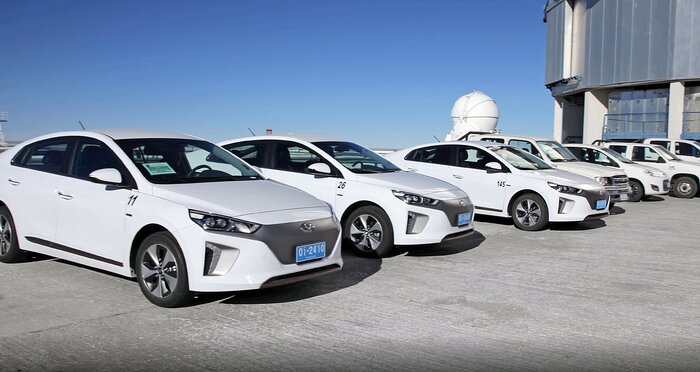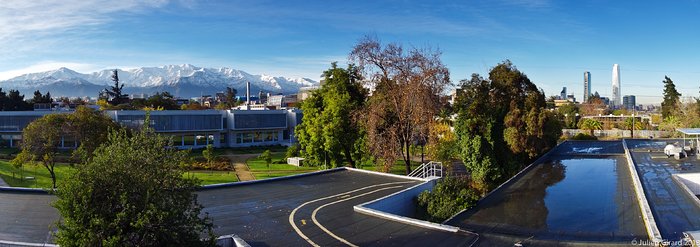Environmental sustainability at ESO
Introduction
Humanity is facing numerous serious environmental challenges, from climate change to increasing pollution and waste. As one of the world’s leading astronomy organisations, ESO has a responsibility to address the environmental impact and sustainability of its activities and operation, ensuring it remains aware of its climate footprint and builds towards a sustainable future.
ESO carries out the design, construction and operation of powerful ground-based observing facilities, providing astronomers worldwide with some of the best tools for their research and discoveries. This work leads to invaluable scientific and technological progress, contributes to social sustainability, in line with the United Nations’ Sustainable Development Goals, and other societal benefits, but also unavoidably places demands on the environment. For example, the use of power-intensive computer systems and the transportation of people and goods needed for scientific research consume energy and resources, contributing to climate change.
To address this impact, ESO has taken a number of measures in the past few years to become more conscious of the environment, including enshrining “sustainability” in the values that guide its work. ESO is committed to pursuing the responsible management of natural, human and monetary resources, acting with a long-term environmental, social, and economic perspective in mind.
A key part of this consists in regularly assessing the environmental impact of its activities, and implementing measures to improve sustainability.
ESO initiatives for improving environmental sustainability
Cutting carbon on a global scale
In a carbon audit conducted in 2019, ESO’s 2018 carbon footprint was estimated to be around 28 000 tonnes of CO2 equivalent per year (tCO2e/yr). In this audit, energy consumption, purchases (including maintenance and equipment), and transporting of people and goods were found to represent the largest sources of emissions.
In 2019, ESO reduced its carbon footprint by about 10% compared to 2018 levels by reducing purchases, energy consumption and travel. The carbon footprint had a further drop, of about ~33%, in 2020, mainly due to the reduced level of operations and staff mobility resulting from the Covid-19 pandemic. The numbers for 2021 are not available at the time of writing, though it’s expected they will increase as operations gradually returned to pre-pandemic levels. Nonetheless, considerable efforts are being made to permanently reduce ESO’s carbon footprint.

Infographic demonstrating the main contributors to ESO’s CO2 emissions in 2018, with ESO’s total carbon footprint for that year highlighted in the centre.
In 2021, ESO’s Directors Team committed to a new set of measures focused on decreasing the organisation’s carbon footprint, reducing waste, cutting greenhouse gas emissions and saving energy. Spanning the full range of ESO’s premises from Garching to Chile, these measures include:
- Running its observatory sites on renewable energy. ESO’s observatory sites are fueled by the Chilean power grid, which includes a significant percentage of renewable energies. Solar arrays have been installed at La Silla and Paranal and in the near future ESO’s observatories in Chile will be entirely powered by green energy. The 9 MW solar array to serve the future Integrated Paranal Observatory which will host ESO’s Extremely Large Telescope, as well as the ESO-operated Cherenkov Telescope Array Observatory South, could save up to 1700 tCO2e/yr, while the La Silla photovoltaic plant avoids the emission of up to 400 tCO2e/yr.
- Divesting from air shipping, preferring sea freight over air freight for transit of materials from Europe to Chile. This could save as much as 1400 tCO2e/yr.
- Reducing business travel, particularly by flight, instead opting for virtual meetings over physical meetings wherever possible. As well as improving accessibility for many, this also potentially could save up to 800 tCO2e/yr. ESO also encourages the use of “service mode observations”, minimising the need for astronomers to visit the observatories and thereby reducing carbon footprints.
- Extending the lifetime of IT equipment, and transitioning to a model of repairing broken devices more frequently instead of replacing them. This may save as much as two tCO2e/yr, and would reduce ESO’s contribution to landfill or scrap yards.
- Increasing the share of electric vehicles and/or encouraging low-carbon transportation at ESO sites, hence reducing the reliance on fossil fuels.
- Integrating sustainability into the design phase of new projects and procurement, employing and collaborating with contractors who share ESO’s concerns on sustainability.
- Monitoring ESO’s emission sources on a periodic basis, producing regularly updated roadmaps for the reduction of our carbon footprint.
The measures outlined are in line with actions taken by ESO Member States, which have committed to reducing carbon emissions under the Paris Climate Agreement. Developed by ESO’s Environment Committee, the measures follow the reports of the Intergovernmental Panel on Climate Change (IPCC) — the United Nations’ body responsible for deepening our understanding of climate change, how it affects our planet and what emission reductions are needed to limit it. ESO's Enviornment Committee is also in the process of developing a comprehensive action plan to gradually reduce ESO’s carbon footprint further over the coming years.
Through a combination of these measures, ESO could potentially prevent the emission of at least 4300 tCO2, the rough carbon footprint equivalent of flying nearly 1000 times from Europe to Chile and back, each year, with further savings expected from local initiatives outlined below. By beginning a transition away from fossil fuels, ESO is paving the way towards a more sustainable future.
Local environmental sustainability initiatives
Driven by its institutional level strategies for reducing its carbon footprint, ESO is also committed to numerous local sustainability initiatives across its sites. ESO has headquarters in Garching, Germany, as well as a planetarium and visitor centre. ESO also has offices in Vitacura, Santiago, Chile. All its observatory sites — La Silla, Paranal and Chajnantor — are located in the Chilean Atacama Desert. The main observatory at Chajnantor is ALMA, the Atacama Large Millimeter/submillimeter Array, 37.5% of which is owned by ESO. As it is owned and operated jointly with other partners, it is not featured on this page.
ESO Headquarters and ESO Supernova Planetarium and Visitor Centre (Garching)
 Bicycles parked outside the ESO Supernova, located at ESO’s Garching Headquarters.
Bicycles parked outside the ESO Supernova, located at ESO’s Garching Headquarters.
ESO’s headquarters in Garching, Germany, house the scientific, technical and administrative heart of the organisation. As such, it is reliant on high-power computing and excellent IT infrastructure. ESO is currently reviewing the energy consumption of its IT Server Rooms to identify the main sources of electricity consumption and take measures to reduce it. ESO has also agreed to promote a low carbon energy plan in Garching: by regularly addressing and investigating sources of energy consumption, ESO will aim to reduce its carbon footprint in Germany by up to 250 tCO2e/yr.
ESO has been mindful of saving resources and remaining sustainable for many years. The facilities that make up the ESO headquarters extension, office buildings and a technical building inaugurated in 2013, have significantly lower energy consumption than typical for buildings of similar size. This is due to the well-insulated façade and because the office building is heated and cooled through concrete core activation. This is where groundwater is used together with a heat pump, and supplied with district heating using geothermally heated water.
In addition, floor-to-ceiling triple glazing in both the new and old buildings, as well as automatically operated blinds, control the amount of sunlight into the rooms. This prevents heating in the summer and heat loss in winter. Furthermore, all computer rooms on site are equipped with efficient air circulation cooling devices of the newest standards. During winter, the cold outside air is used to cool the computer rooms, reducing power consumption.
Green measures have also been incorporated into the design of the ESO Supernova Planetarium & Visitor Centre. The facility received the DGNB (Deutsche Gesellschaft für Nachhaltiges Bauen or German Sustainable Building Council) Gold certification for sustainability with respect to its "green economical, socio-cultural, technical and ecological aspects".
ESO is also committed to reducing waste and pollution, encouraging the separation of waste and recycling of multiple materials at its headquarters. It also supports Stadtradeln, a competition and campaign to support climate protection and promote cycling in Germany, and has chargers for electric cars available on site. In addition, to promote biodiversity, there are bee hives on the Garching site.
Paranal initiatives
Paranal is the home of ESO’s Very Large Telescope (VLT), the VLT Interferometer, as well as two survey telescopes, VISTA and VST. In the nearby Cerro Armazones, ESO is building its Extremely Large Telescope (ELT), which will be operated from the Paranal Observatory.
In 2017, Cerro Paranal and Cerro Armazones were connected to the Chilean national grid, reducing costs and sharply decreasing the observatory’s carbon footprint (the footprint related to electricity generation dropped from 12600 tCO2e/yr to about 4600 tCO2e/yr). Power is instead provided by grid electricity, which includes a significant percentage of renewable energies. The connection was enabled by the Chilean government, and is managed by the Chilean Grupo SAESA. Further, the Chilean government aims to increase the green energy component from 11% in 2016, to 40% in 2030, further decreasing the percentage of fossil primary energy.
In 2022, ESO inaugurated a 9 MW solar array to serve the future Integrated Paranal Observatory which will host the ELT, as well as the ESO-operated Cherenkov Telescope Array Observatory South. This facility could save up to 1700 tCO2e/yr. The solar plant will also serve as a backup energy plant to the region of Antofagasta, supplying energy to the local community via the grid in case of a widespread power outage.
While power saving has been a huge objective at Paranal, energy requirements remain high due to the advanced technology used on site. To reduce consumption, Paranal has taken numerous steps including the introduction of LED light bulbs in the Control Room and the Residencia, and will soon replace the 1000 W spotlights in the telescopes with more efficient light sources. In addition, they will expand the installation of solar panels on site to provide hot water for the Residencia and gradually replace the existing gas boilers.
ESO has also installed a new, more modern laser guide star system at Paranal, reducing the power consumption to just a tenth required by the old laser. Similar low-power-consumption lasers will be installed in other VLT telescopes, as well as on the ELT, in the near future. Discussions are also ongoing to introduce measures to cool the telescopes more efficiently.
Due to their isolated nature, ESO’s operations in the Atacama Desert pose significant logistical challenges. At both its Paranal and Chajnantor observing sites, food, water and all other consumables have to either be locally produced or delivered from nearby cities. Water usage has been kept to a minimum by the installation of low-consumption showerheads, while the introduction of new cooling chambers in the kitchen has reduced the need for food transport. Electric cars have also been introduced to the Paranal fleet to reduce the carbon footprint of transportation to and in the Desert, with eight new electric-car chargers planned for installation in 2022.

A fleet of electric cars parked outside ESO’s Paranal Observatory.
Further, a new, sustainable office building was inaugurated in Paranal at the end of 2021. Staff in Paranal normally commute by car from their accommodation in the Residencia to the Control Room, located up the mountain near the telescopes. Due to its proximity to the Residencia, commuting time to the new office building is drastically reduced compared to trips to the Control Room. This results in less car usage and fewer CO2 emissions. Further, the new building combines solar panels, batteries and the use of LED lighting, providing the ability for the offices to function self-sufficiently for up to 36 hours.
Lastly, ESO remains committed to the heritage of Chile-based astronomical sites, promoting natural conservation programmes and an awareness of the local culture and history, particularly in Coquimbo and Antofagasta, where observatories are located. In partnership with the Chilean government and international collaborators, ESO is actively committed to preserving the legacy of Chile’s dark skies, recently petitioning the UN for legal protections for ground-based astronomy.
La Silla initiatives

The solar panels that form part of the photovoltaic plant powering ESO’s La Silla Observatory.
ESO has also been working to reduce the carbon footprint of La Silla, its first observing site and one with a long history of environmental sustainability. The La Silla photovoltaic plant, inaugurated in 2016, has capacity to produce 1.7 MW of power and avoids the emission of up to 400 tCO2e/yr. As a result, all electricity used at ESO’s La Silla Observatory during the day is renewable. The plant exploits solar energy through the use of solar panels that cover an area of more than 100 000 square metres on the La Silla site.
ESO sites are ideal for solar energy, providing over 320 clear nights (and days) per year, with access to an abundance of sunshine. In combination with a vast improvement with solar cells, this has made solar energy a reliable and almost maintenance-free alternative to fossil fuels, ideal for the requirements of astronomical observatories. Further, solar thermo-panels are used to provide hot water to some of the La Silla dormitories, with new panels planned for installation in the near future.
Power consumption at the site has been reduced significantly by introducing LED lighting throughout the facility, as well as implementing motion sensors for lights at the La Silla Hotel. Further, no single-use plastics are used at the site, with water dispensers and reusable containers provided to staff and visitors instead. Food waste is also minimised, with food scraps composted on site.
ESO Vitacura initiatives

ESO’s Vitacura Offices in Santiago, Chile. In the background are the Chilean Andes.
The Vitacura site is the hub from which ESO supports its organisational operations within its host and partner country, Chile. It is from Vitacura that ESO collaborates with Chile and its authorities, scientific community and society. At Vitacura, ESO has implemented recycling infrastructure for glass, cardboard, plastics, batteries and more in both the main and satellite buildings. Groundwater is used to nourish Vitacura’s garden and its many plants, trees and green areas. The garden is also being remodeled to reduce water consumption by decreasing grassy areas and expanding dry sections.
Vitacura is also shifting to renewable energy as part of a four-year plan of infrastructure improvements, upgrading the heating and cooling systems of the office buildings with green alternatives, and installing solar panels on the office roofs. This will correspond to a potential saving of 200 tCO2e/yr by the time the full transition is complete in 2025. The Vitacura offices currently use electric cars, further minimising fossil fuel consumption and pollution.
Way forward
ESO’s status as the world’s most productive observatory positions it as a responsible leader in the astronomy community’s response to climate change. To that end, ESO is always reviewing and increasing its actions towards improving sustainability and preserving the heritage of our planet for future generations.
In 2022, ESO committed to recruiting a Sustainability Officer to support environmental projects and coordinate responses and strategies across the organisation. ESO is actively committed to reducing CO2 emissions, using renewable fuel where possible, reducing pollution, saving water, and preserving the legacy of our night skies.
“ESO’s current and planned environmental sustainability actions represent a starting point. ESO is committed to regularly analysing its sources of emissions and to continue to take steps to reduce its carbon footprint,” says Claudia Burger, ESO’s Director of Administration and Chair of ESO's Environment Committee.
ESO is also aware of its platform and institutional status. ESO is committed to communicating clearly and transparently with its staff, encouraging an open dialogue about climate change. ESO will also address the general public, frankly discussing astronomy’s impact on both the climate and CO2 emissions, as well as reassuring the community as to why ESO is committed to sustainability and how it will aid in the fight against climate change.